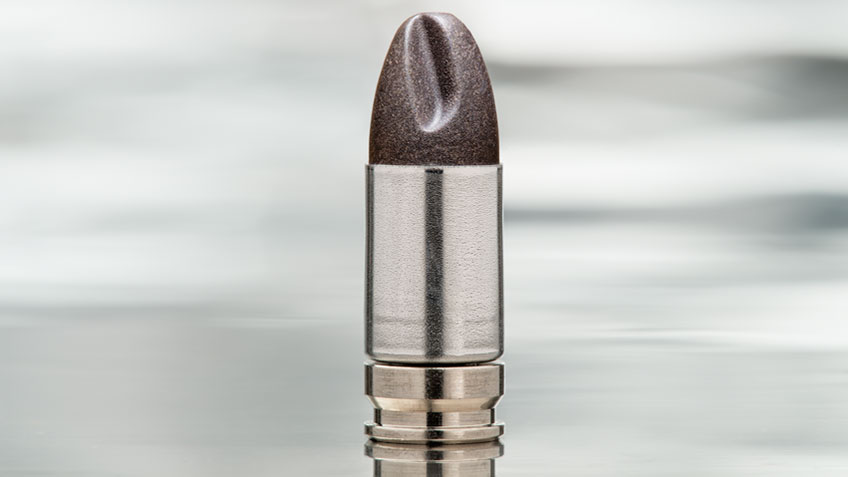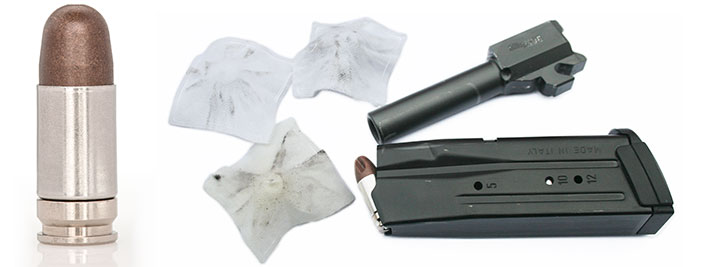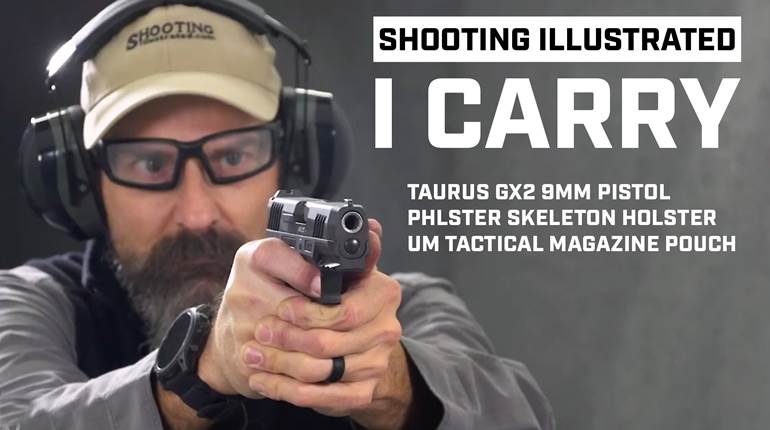
From component materials to design and appearance, little about NovX cartridges is conventional.
New” ideas in ammunition are typically incremental, as the metals utilized in its construction—lead, copper and brass—have been employed since at least the late 19th century. In fact, most bullets are still of the jacketed, lead-core design and the majority of cases are brass. Clearly, little has changed with time. Breaking with convention, though, can lead to brilliant design breakthroughs. Case in point: NovX Ammunition.
A holding of Timberghost Tactical, LLC, based in Calhoun, Ga., NovX Ammunition was founded on the premise of supplying military, law enforcement and civilian consumers “the most innovative, powerful, effective and deadly [ammunition] ever.” That’s no easy feat. In an effort to meet that rather lofty goal, NovX brought together two emerging technologies: Polycase’s ARX and RNP bullets and Shell Shock Technologies’ (SST) cartridge case.
 Inseparable: Polycase And SST
Inseparable: Polycase And SST
“The Polycase [now Quantum Ammunition] ARX design is the best-kept secret in the industry,” confided NovX Ammunition President/CEO Scott Schultz. “As a personal-defense round, it’s beyond compare.”
Manufactured via the efficient, high-pressure injection molding process, the fluted ARX and its round-nose RNP stablemate are comprised of blended copper powder (about 80 percent), epoxy and polymer. Since the composition lacks lead, the ballistically matching projectiles can be used on ranges requiring lead-free loads. Moreover, they’re sufficiently tough to traverse a bore unaffected, yet they fragment—into particles less than five percent of the total weight—upon impact with especially hard objects, such as concrete and hardened steel. The non-expanding bullets easily defeat intermediate barriers, such as clothing, wood and thin sheet metal.
As can be expected, ARX/RNP bullets are lightweight. For example, whereas most standard 9 mm (0.355"-diameter) bullets weigh at least 115 grs., the copper/poly projectiles are only 65 grs. This enables them to be propelled extremely quickly, thereby increasing the foot-pounds of energy delivered on target through speed. The latest iteration of the NovX 9 mm Luger is labeled “Engagement: Extreme Self-Defense” and achieves 1672 f.p.s., resulting in 403 ft.-lbs. of energy. Meanwhile, the +P version hits 1710 f.p.s. for 422 ft.-lbs. of energy. That’s more energy than typical 230-gr. .45 ACP loads.
Beyond increasing on-target energy, the additional velocity greatly enhances the ARX’s terminal effect. “The fluted design of the ARX bullet is quite amazing, as it operates on the principle of fluid dynamics rather than hydrostatic shock,” explained Schultz. Molded into the projectile are three distinct flutes that, as the bullet penetrates soft tissue (and fluid), transfer the forward energy laterally. The fluids, spinning at around 120,000 rotations per minute (r.p.m.), are forced in an outward direction at upward of two times the speed of the bullet itself. “A new phenomenon has been realized,” Shultz said. “NovX can achieve breaking the liquid sound barrier, actually causing a sonic boom inside whatever water-based material it may encounter—water, clay, gel, flesh, blood, et cetera.”
Direction of rifling is inconsequential, too. Despite being a non-expanding bullet, the cavitation the ARX produces is immense. Until it’s seen firsthand, it’s almost unbelievable; however, there is no smoke, and there are no mirrors.
The increased velocities achieved through the projectiles’ light weight also flattens trajectories and, since bullet weight is a factor in recoil, perceived recoil is reduced. The result is less discomfort and faster follow-up shots.
In another display of eschewing tradition, NovX selected an atypical case for its Engagement: Extreme Self-Defense (ARX) loads and Cross Trainer/Competition (RNP). Manufactured in the United States by Shell Shock Technologies (SST), the bi-metal cases are upward of 50 percent lighter than those of brass, and twice as strong. Purportedly, the cases have a pressure rating of 65,000 p.s.i. and can be reloaded—which should not be taken as an open invitation for dangerous loading practices—however, that requires special sizing/de-priming and expanding/flaring dies available from SST.
According to SST’s website, the primer base is made from nickel-plated aircraft-grade aluminum, while the cylinder of the cartridge case is nickel-alloy stainless steel. The benefits of the design are many. For example, the base is easy on extractors and ejectors, while the cylinder is corrosion-resistant, exhibits excellent thermal characteristics and is magnetic. The latter eases clean-up at the range. Further, the cases won’t chip or crack, have higher tensile strength (twice that of brass, so less crimp is required), work well in unsupported chambers, and, reportedly, generate faster, smoother cycling. Ejected cases are also cooler to the touch than brass. Lastly, the cases’ natural sheen makes them easy to see through a magazine witness hole or during a low-light press-check.
Concerning propellants, Schultz said, “At first we loaded the NovX stainless steel case with similar powders and loads as brass. We experienced superior velocities and performance to brass, and we assumed that was that. However, as we continued to experiment with other powders, we were able to push velocities well over 1700 f.p.s., while staying within SAAMI pressures.” The company just finalized a new 9 mm Luger +P load that achieved more than 1800 f.p.s. (and 467 ft.-lbs.) of energy from a 4" universal receiver with cut rifling. To this Schultz added, “This amazing performance is only possible because of the superior characteristics of our nickel-alloy stainless steel case. I never realized how much shot energy was absorbed by the brass case.”

At The Range
My evaluation of first-generation NovX ammunition began with the requisite accuracy testing followed by chronograph recording. Using a 4"-barreled SIG P250 from a sandbag rest at 25 yds., I fired five consecutive, five-shot groups with NovX 9 mm Luger +P Engagement: Extreme Self-Defense, averaging 1.93". The single best group was 1.52". Similarly, 25 shots with 9 mm Luger +P, Cross Trainer/Competition produced a mean of 2.28", and the best single group was 1.77".
Since the two loads are described as being ballistically matched, I then shot five ARXs, followed by five RNPs—all on the same target, then repeated that string. The two groups measured 2.21" and 3.46", respectively. There was no apparent separation between the two loads.
According to a Competition Electronics Pro Chrono digital chronograph, the Engagement: Extreme Self-Defense load averaged 1659 f.p.s. for 10 shots at 10 ft., producing 397 ft.-lbs. of energy. The standard deviation was 14. This early iteration had a published velocity of 1655 f.p.s.—only a 4-f.p.s. difference! The Cross Trainer/Competition load was a tad slower, averaging 1613 f.p.s. It’s standard deviation was 16. Its reported velocity was 1635 f.p.s.

Next, I transitioned to function testing. The P250’s magazines were filled to capacity with both NovX loads in random order and then fired in rapid succession at an AR500 plate rack and dueling tree. Despite the ARX’s unusual nose profile, feeding was flawless, and both rounds hit the hard steel with authority. As they were designed to do, the bullets fragmented immediately upon hitting the targets, eliminating bounce-back.
With more than 200 rounds of NovX sent downrange, the gun was disassembled and cleaned, and there was virtually no fouling in the bore. In fact, a single patch soaked with Montana Xtreme Bore Solvent followed by two dry ones were all that was needed to shine the bore. With cleaning completed, testing resumed.
For comparison sake, I also alternated firing standard 115- and 124-gr. defensive 9 mm Luger loads with those from NovX. Immediately noticeable was the lighter recoil, as was the weight of the loaded magazine (and gun). Back at home, I learned that, with an average loaded-cartridge weight of 105.8 grs., 10 rounds of 65-gr. Engagement: Extreme Self-Defense 9 mm Luger +P cartridges weigh 2.42 ozs. With an average weight of 178.5 grs., 10 rounds of 115-gr. Hornady Critical Defense FTX add up to 4.08 ozs. Lastly, with an average weight of 188.3 grs, 10 rounds of 124-gr. Federal Premium HST loads weigh in at 4.30 ozs. The latter is approaching nearly double the weight of the NovX. For the owner of a lightweight pocket pistol, such as the 12.7-oz. Kel-Tec PF-9 or 14-oz. Kahr CM9, that difference in weight could make a noticeable difference in comfort after a long day carrying concealed, and more so in semi-automatic pistols with larger-capacity magazines.
Having shot ample reactive steel targets, I was able to substantiate NovX’s claim that the bullets disintegrate upon impact with hard targets. How about intermediate barriers? B. Gil Horman, a field editor for this magazine, had an opportunity in the past to shoot the then-new ARX bullets from a 9 mm Luger into ballistic gelatin through denim. It easily defeated the light barrier and penetrated 13". To further test, I fired ARX rounds through a suspended, remnant steel hood from a junker car, and they zipped through it easily. The same occurred when pitting the rounds against 5" (give or take) saplings and a 2"x4" stud. Talk about an intelligent design. It easily defeats intermediate barriers, yet breaks up when striking a hard material that could otherwise cause a ricochet.
In an effort to evaluate the terminal performance of the ARX versus a popular self-defense bullet, I shot one round each into 25-lb. blocks of soft ceramic clay at 7 yds. As will be evident in the accompanying images, the difference is tremendous. The ARX bullet literally blew the block apart before exiting. Of the material remaining, at its widest, the cavity measured an impressive 4 3⁄8". The spirals caused by the lateral displacement were especially evident near the exit.

In comparison, the 124-gr. Federal Premium HST bullet—one of the top self-defense and duty rounds on the market—produced a small entrance and exit, with the block bulging (but not rupturing) near its center. Splitting the block, the cavity measured 4½" at its widest. In terms of absolute damage, the ARX won on clay blocks, though the HST is made to defeat all FBI barriers—the ARX is not. Both, however, would stop a threat.
Currently, NovX is offered only in those 9 mm Luger loads identified in this article, though that should be changing soon. Schultz has informed me that .223 Rem. will be on the market soon, followed by .308 Win., .300 Blackout, .45 ACP, .40 S&W, .380 ACP and .38 Spl. The .223 Rem., in particular, has astounding specifications; it will propel a 35-gr. poly/copper bullet to 4150 f.p.s.! At some point later this year there’ll be a mini ARX bullet loaded in .22 Long Rifle with a muzzle velocity of 2050 f.p.s. Talk about perfect for small-game hunting in lead-free areas.
Sold in 26-round boxes, Engagement: Extreme Self-Defense is priced similarly to other premium defensive loads. Cross Trainer/Competition comes in 51-count packages and is about half the price of the self-defense offering.
“NovX’s technology and high performance could forever change the world of ammunition,” proclaimed Schultz. From what I’ve encountered during testing, that’s a claim that is difficult to counter. It’s also indicative of what’s possible when forward-thinking individuals deviate from the norm.
For more information on NovX Ammunition, go to novxammo.com. NovX is currently available through online retailers MidwayUSA and Natchez Shooters Supplies.





































